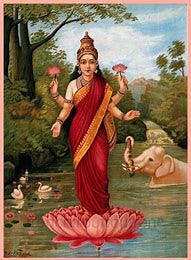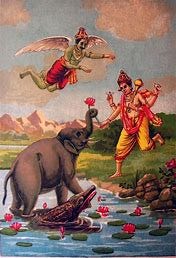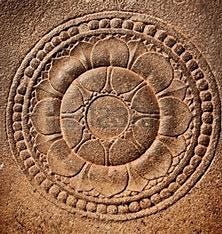Lotus is one of the most recurring motifs in Indian (and South Asian) culture. One can see its presence in art, architecture and mythology throughout the subcontinent. Earliest scriptures like Rigveda mention that people should be lotuses- surrounded by difficulties (mud) yet unsoiled by it. Lotus is the most-of repeated metaphor for purity. But its also a metaphor for beauty, for perfection, for symmetry. Historians think that lotus was found abundantly in ancient India, no wonder it is so deeply rooted in Indian art, architecture and literature.
Kamalnayan (or the lotus-eyed) is one of the thousand names for Lord Vishnu, mentioned in the Vishnu Sahasrnama. Throughout Hindu mythology, lotus features prominently. Puranas are an important genre of religious texts in Hinduism. One of the Puranas is in fact named after the lotus (Padma Purana). Multiple gods and goddesses (especially Lakshmi, the goddess of wealth and Ganesh, the god of wisdom) are featured sitting on lotus thrones. Lotuses come in a variety of colors and each color is supposed to represent an emotion. Margaret Redlich, a Chicago based film critic did her undergraduate studies in oriental history. “I could not understand why lotus as a metaphor was repeated so much! When I was reading the Shiv Purana. The god was once described as having angry eyes like red lotuses. Why not just say red eyes? I did not realize how important the lotus was as symbol in Indian culture” she says.
Lakshmi on a lotus
Lotus is especially important to the iconography of Vishnu. When Lakshmi chose Vishnu as her consort after the churning of the ocean (Samudra Manthan) she put a garland made of lotus flowers around his neck. In fact, lotus garlands are still used in many Hindu weddings Lotus is also one of the four attributes borne by Vishnu (the other three being Shanka, Chakra and Gada). In certain texts, Vishnu is referred to as Padmapani- the ones whose hand is shaped like a lotus. Vishnu is also referred to as a god having lotus shaped eyes. According to one tale, Vishnu was worshipping Shiva with 1008 lotuses. However, Shiva cleverly hid one lotus. In order to compensate for this loss, Vishnu decided to offer one of his lotus shaped eyes instead. Impressed by his devotion, Shiva granted him the Sudarshna Chakra.
Another fable says that Gajendra Moksha, the king of elephants was an ardent devotee of Vishnu. He loved offering lotuses to his favorite deity. Once, he was picking lotuses from a lake as usual when a crocodile caught hold of his leg and would not let it go. Gajendra was sinking deeper and deeper into the lake. Exhausted, Gajendra held up a lotus in his trunk and called to Vishnu. Vishnu descended from the heavens and beheaded the crocodile.
Something like this
White lotuses represent wisdom. No wonder Brahma, the creator is often depicted sitting on a white lotus. In fact, Saussurea obvallata or the Brahma Kamal is very closely associated with Brahma. One legend says that Brahma created the Brahma Kamal plant. In one story, he meditated on a lotus flower and then he fell asleep. When he woke up, he discovered that he had turned into a lotus himself. The flower then became known as the Brahma Kamal. Another tale says that Brahma created the universe through the brahma Kamal. The flower bloom just once every year and that also for just one night. This further adds to the mysticism and divinity associated with the flower.
In epics like Ramayana and Mahabharata, both Lord Rama and Lord Krishna have been described as having dusky skins, resembling the petals of a blue lotus. In Mahabharata, the multi-tier military formation was in the shape of a blooming lotus and was called the Padmavyuh. The chakravyuh was a variant of it. In the Bhagavad Gita, Lord Krishna describes himself as a lotus amongst all other flowers.
Given how important lotus is to Hindu mythology, it is not surprising that millions of Hindu boys and girls are named after the lotus. Rajiv, Kamal, Neeraj and Jalaj are all synonyms for lotus. When it comes to girls, they are often named Kamala, Padmaja and Jalaja. All these literally mean, “the one born out of lotus” and are actually names for goddess Lakshmi.
Lotuses are a prominent feature in Jain and Buddhist traditions as well. The sixth Jain Tirthankara, Padmaprabha was born to King Shridhar and Queen Susimadevi of Kaushambi. Padmaprabha means ‘bright as a red lotus’. Legend has it that his mother had a fetish for couches made up of red lotuses, hence he was born looking like a red lotus. In Jain Ramayana, the name of the protagonist is Padma (lotus).
In Buddhism, lotus is one of the eight auspicious symbols. Supposedly Buddha’s mother had a dream about an elephant carrying a white lotus in its trunk ,just before giving birth to him. When Buddha was born, he already had the ability to walk and wherever he walked, lotuses bloomed. Amitabha Buddha, one of the earliest forms of Buddha is almost always depicted sitting or standing on a lotus. Further, the Lotus Sūtra (Saddharma Puṇḍarīka Sūtra) is one of the most popular and influential Mahāyāna sutras or prayers. Paintings in Ajanta Ellora caves are filled with figures holding lotuses.
Lotuses are critical in yogic and tantric traditions too. The eight petaled lotus represents the womb of cosmic existence in tantric philosophy. In yogic traditions, enlightenment is attained when the consciousness travels upwards through the spinal cord. Every critical point in the journey is symbolized through the blooming of a lotus. Each lotus in the journey has more petals than the one before it. Enlightenment is attained when the consciousness reaches the head and a thousand-petal lotus blooms. Padmasana (or the lotus position) is an extremely popular sitting posture for meditation in Hindu, Jain and Tantric traditions. This is a cross-legged position in which each foot is placed on the opposite thigh.
Lotuses are also important in folk art. A woman holding a lotus bud is deemed to be a virgin and a woman holding lotus blooms indicates that she has sexual experience. In some regions, Lajja Gauri (a form of Parvati) is depicted carrying lotuses in her hands and having a lotus shaped head. Her genitals are exposed, she is the shy mother goddess who was embarrassed when sages trespassed on her in the forest as she was making love to Shiva. When it comes to region-specific mythology, Pichwai paintings of Rajasthan depict Krishna as Shrinath Ji from the age of 7, holding lotuses at various stages of blooming. The life cycle of the lotus in these paintings represents human life from birth till death. In Mandana paintings in Rajasthan and Madhya Pradesh, lotuses are depicted having four, eight or sixteen petals. It is said that goddess Lakshmi resides in these lotuses. Women draw these paintings in front of their doorsteps because they believe that doing this would attract wealth and prosperity. In Madhubani paintings of Bihar, lotus flowers are used to depict feminine beauty and lotus stems represent female power.
Lotus appears repeatedly in architecture. India’s national emblem is the Lion Capital of Ashoka that was originally erected in Sarnath, Uttar Pradesh. The emblem consisted of four lions set back-to-back on a drum-based abacus that is mounted on a lotus turned upside-down.
Ruins of Hampi tell us how important lotuses a motif for the sixteenth century city were. Archaeologists have uncovered a magnificent elephant stable with domes shaped like lotuses. The Lotus Mahal, a palace that was probably meant for entertainment the royal family of Vijayanagar has also been unearthed. The dome gives an illusion of an open lotus bud.
The lotus flower as a decorative motif is found throughout the subcontinent in the form of relief carvings on temples, havelis, stepwells, palaces etc. Lotus medallions have been found in ruins of ancient cities of Sanchi and Beirut. Islamic architecture forbids the depiction of human figurines. Thus, in monuments like the Taj Mahal you may never find the depiction of a human being on a wall but ornamental engravings are plenty. Regardless to say, lotuses form an important element within these engravings. Mughal painters loved including symmetrical elements in their paintings. Lotuses are often used in Mughal paintings in an extremely symmetrical way. Royalty and aristocracy are also often shown holding lotuses in their hands. Royal ladies are frequently depicted bathing or playing in lotus ponds. Handicrafts like blue pottery in Rajasthan also heavily use lotus for decoration.
Lotus carved on the inside of a temple dome
Jharokas, a formed of stone carved windows are an architectural marvel used in buildings throughout North India. A lot of these use intricate designs that look like lotuses.
Maybe the most contemporary example of use of of lotus in art and architecture has to be the Lotus Temple in New Delhi. This is a Baháʼí House of Worship or Baháʼí temple. It is composed of 27 free standing marble petals arranged in clusters of three to form nine sides.
It is not just the flower but also the stem (Kamal Kakari) that is an integral part of South Asian cuisine. It is eaten in the form of chips, curries and pickles. Lotus stem is called nadru in Kashmir. According to the research done by JK Arts Foundation, “nadru was first ‘discovered’ in any significant capacity in the valley in the fifteenth century CE, when the Kashmiri sultan Ghiyath al-Din Zain al-Abidin went for a leisurely ride in the Gul Sar (now known as the ‘Gill Sar’) lake in the outskirts of Srinagar city. There, he spotted the magnificent lotus flowers and was captivated by their beauty. His boatmen, moreover, harvested some of the flower and included the nadru in the evening meal. The sultan was caught off guard with the subtle, sophisticated and yet unique taste that this mysterious plant brought to the table and immediately decided to expand the natural habitat of the lotus plant into other prominent lakes close to Srinagar so that he could access its flavorful stems more easily. In this context, the invasion of Timur and a number of his retinue including his royal cooks settling down in the valley was fortuitous as they extensively experimented with the intriguing lotus stem in their kitchens and came up with numerous dishes”.
Go, cook it!
Multiple British ethnographers and writers like William Jones and Max Müller (though German, he was influential in British Indology) have written about significance of lotus in Indian culture. Few have also regarded the lotus as a symbol of mysticism and otherworldliness. This is often the characteristic trait of western scholars studying the east. Indo- European architecture (like the Gateway of India) also encompasses traditional Indian motifs like the lotus.
In modern India, the legacy of lotus as a cultural icon lives on. It’s the national flower of India and also the symbol of its current ruling party, the Bhartiya Janata Party.






